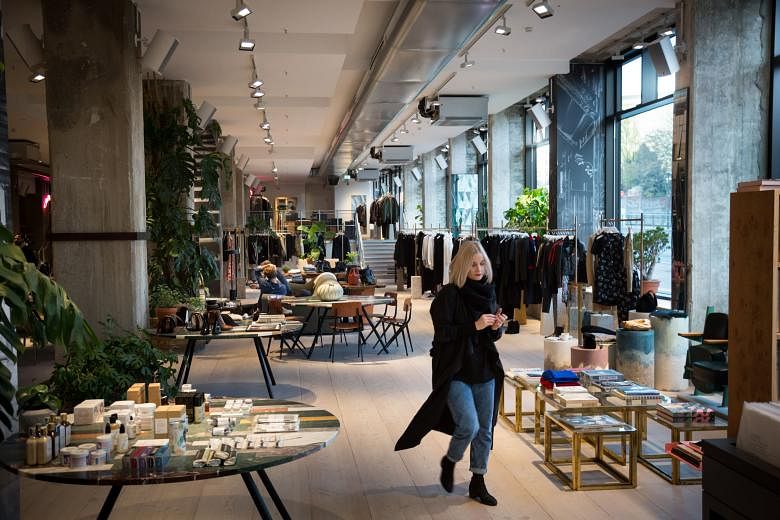When Mr Blake Mycoskie, the founder of shoe company Toms, began talking with its executives a few years ago about opening retail outlets, he faced an impasse right from the start. It was over the word "store".
"I didn't want to start with a store," he said. "I didn't feel like that added any value."
Instead, he recalled arguing with his colleagues. "I said, 'We have to call them community outposts.' An outpost seemed like more of a meeting centre, an area for information, almost a political rallying point. This is the place where things are happening."
He prevailed and the company opened its first Toms Outpost three years ago in the Venice section of Los Angeles. A visitor will find a back patio with seating, free Wi-Fi and events such as morning yoga classes and movie nights. There is also a cafe serving cups of Toms coffee, a recent brand expansion.
And, oh yes, grouped in distinct spaces around the room, traditional Toms products such as shoes and eyeglasses. As Mr Mycoskie put it, the idea was to create "a lifestyle for the brand".
The Toms Outposts - there are now seven, with plans for more - are part of a reimagining of the fashion retail experience that has been taking place.
The standard store, with its static racks, tables of merchandise and salesmen who can sometimes be unwelcoming, suddenly seems undynamic. And the luxury boutiques, with their hushed, gallery-like atmosphere, feel sterile to many younger shoppers.
What is developing instead is a model of the retail store as a community centre, a welcoming environment that offers experiences as well as products.
In recent years, brands such as Club Monaco have gone partway, carving out space in their stores for things such as coffee and books. But the new model almost upends that thinking, putting communitybuilding attractions in the foreground and making the apparel itself an afterthought.
That is the concept at the Store, for instance, a retail space that opened in January inside Soho House Berlin. There are comfy, oversized couches by renowned Belgian designer Axel Vervoordt, plants everywhere, and a kitchen serving organic dishes. A DJ plays music and regular art installations are held. On a daily basis, people may spend hours on their laptops, just hanging out.
"It's a place to be, a creative hub," said Ms Alex Eagle, the Store's creative director. "It's about a fresh-pressed juice as much as it is about an Issey Miyake sweater."
Indeed, only about one-fifth of the 30,000 sq ft space is dedicated to traditional retail. That may seem like a risky business strategy, but Ms Eagle said that filling the floors with merchandise would not have been a competitive advantage.
"With everything being so easily available a click away online," she said, "you have to offer an experience. People want something for their time."
E-commerce, it turns out, is the big driver for brands to create community-focused retail spaces. If people can get fashion delivered to their doorsteps, why go to stores?
"Getting people into stores has become a huge challenge because the e-commerce experience gets better and better," said Ms Kim Vernon, a fashion brand consultant and industry veteran. "The smartest thing you can do is to get people in your store."
The ways brands are doing that vary. Some, such as Toms, are turning to coffee and events. Kit & Ace, a new streetwear brand with retail outlets in Canada, England, Australia and the United States, holds quarterly Sunday Suppers, catered by a local chef and promoted by word of mouth.
Ms Nina Garduno, who founded the retail outlet and artist commune Free City Supershop in Los Angeles, is teaming up with Light In The Attic, a record label, to open a pop-up record store in January. The concept is the latest in an annual reimagining of her retail space in which she and her team develop a theme, asking artists to help create products, decor, art installations and events around it.
In many ways, Ms Garduno was ahead of the curve. When she opened Free City Supershop in 2010, she said she envisioned the space like a laundromat in that "it brings your neighbourhood together". She added: "It's not enough to find more ways to make money, sell more clothes. It's not giving enough. People don't want to just buy to buy."
That giveback thinking appeals to millennial shoppers, many of whom show an interest in social issues such as the environment and a desire for philanthropy. They like to know that the money they spend has a positive impact. Fashion brands, too, want to convey to consumers that their company stands for something beyond profits.
Philanthropy and communityminded stores are also a good strategy to battle the retail headwinds facing the industry.
In opening the Toms Outposts, Mr Mycoskie said his company had to learn new businesses such as food and beverage and, in some cities, open its stores at the unheard-of hour of 6am for the commuter crowd.
But the decision was worth it, he said. Just as it was worth it when he decided nine years ago to start a company that would give away a pair of shoes to a needy person for every pair sold.
"There's still room for companies that make beautiful products and that's their sole purpose," he said. "But I do think it's a competitive advantage if you make a great product and have a larger purpose that people can be a part of."
NEW YORK TIMES

